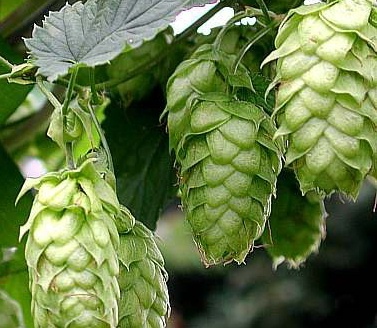Beer is food. Brewers follow a recipe involving grain, herbs, yeast and water to create a beverage. That beverage can very widely depending on the type and amounts of the various ingredients, just as there are wide flavors in the broad category of bread.
Julie Jenney, educational programs coordinator at the Scott Arboretum of Swarthmore College in Pennsylvania, and Tim Boland, director of the Polly Hill Arboretum at Martha’s Vineyard, Mass., discussed these basic ingredients during a program on “The Botany of Beer” in late July at the Coastal Maine Botanical Gardens near Boothbay.
Jenney said hops is the spice of beer and malt is the soul of beer, but it all begins with yeast.
“Consider yeast as a little Pac-Man figure going through the wort, eating the sugar and burping out carbon dioxide from one end and leaking alcohol from the other,” she said.
Yeast adds flavor, which can range from what she said was a horse-blanket muskiness in some of the sour ales to green apples, buttery sweet corn and fruit esters.
Hops has the botanical name “humulus,” Boland said, and is in the hemp or cannabaceae family, making it a close relative of marijuana. “If you’ve been driving around with a lot of hops in your car on a hot summer day, you don’t want to get stopped by the police,” Boland said. There is nothing wrong with transporting hops, but the aroma could bring some unwanted attention.
Although people call hops a vine, it isn’t. It’s a bine, Boland said, and climbs using hair-like structures that attach to the support system rather than with a true vining action. The part of the hops that people care about for beer are the tiny yellow resins found deep inside the hops blossoms. These resins, in addition to adding flavor to beer, are an antiseptic that helps prevent spoilage.
When boiled in water, the resins release an oily substance that provides some of the silky mouthfeel you get while drinking many beers, Jenney said.
The blossoms come only on the female hops plants, so hops growers plant only females.
Grains are produced from the grass family (Poaceae), which Boland said is the third largest plant family behind orchids and sunflowers. The most common grain used in beer is barley — grown mostly in the Dakotas, and mostly as a feed grain — but brewers also use wheat, rye, oats, rice, corn and more.
Barley comes in two-row and six-row types, with two-row producing more sugars and less protein and being the one most commonly used for beer. Some beers do use six-row barley, but it’s more commonly used for animal feed.
The grains have to be malted — allowed to partially sprout, converting starches into sugar — before it can used to make beer.
The CMBG program went well beyond botany, however. It included tastings of seven beers. I was a volunteer, so did not get to sample, but I had tried all of the beers before. And the program included some good beer-drinking tips.
The tasting beers were Boothbay Brewing’s 633 and Black Rocks Stout, which I wrote about last week; Peak Organic’s Summer Session, a refreshing mix of a wheat beer, West Coast Pale Ale and IPA, a highly floral version of the style; Sam Adams Boston Lager, a fine example of a craft lager; Gritty’s Pub Style, a genre buster that is a bit maltier than a pale ale; and Sebago’s Runabout Red, my favorite year-round beer from that brewery, which is fairly malty but not overly sweet.
One point Jenney made that was new to me is that the typical bar’s tapered beer glass was not made for, and is not ideal for, beer. It was made to be used with a metal top for shaking drinks, she said.
She said the ideal beer glass is shaped in the same manner as a Guinness glass, with an expanded area near the top and narrowing down at the rim. That allows the beer’s flavors to concentrate in the glass, so you can smell them better before you drink the beer.
REDHOOK BREWERY, 1 Redhook Way, Portsmouth, N.H., is holding HookFest at 2:30 p.m. Saturday, featuring five bands and lawn games, along with a barbecue. Admission price is $20 in advance at redhook.com and $30 at the door, and people will need to bring cash to buy food and drinks inside.
Tom Atwell is a freelance writer living in Cape Elizabeth. He can be contacted at 767-2297 or at:
tomatwell@me.com
Send questions/comments to the editors.



Success. Please wait for the page to reload. If the page does not reload within 5 seconds, please refresh the page.
Enter your email and password to access comments.
Hi, to comment on stories you must . This profile is in addition to your subscription and website login.
Already have a commenting profile? .
Invalid username/password.
Please check your email to confirm and complete your registration.
Only subscribers are eligible to post comments. Please subscribe or login first for digital access. Here’s why.
Use the form below to reset your password. When you've submitted your account email, we will send an email with a reset code.